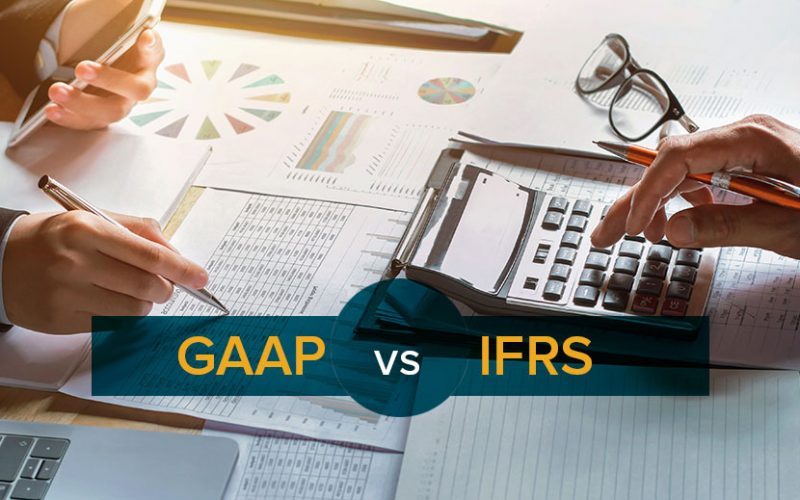Over the years, accounting has become the universal “language for business.” This is because it is capable of providing crucial insights into a company’s financial health and prospects, as well as driving strategic decision-making that leads to new enterprises and investment opportunities. But it isn’t just enough to merely understand the benefits of accounting. It is more important to grasp the standards that govern how organizations record transactions and report finances if you want to advance your accounting expertise. Here’s how the two most common sets of accounting rules, GAAP and IFRS, differ (GAAP vs. IFRS).
An Overview of GAAP vs IFRS
Financial reporting and accounting requirements differ from country to country. As we already know, the Financial Accounting Standards Board (FASB) establishes financial reporting methods in the United States; (GAAP). Generally accepted accounting principles (GAAP) refer to a collection of widely accepted accounting principles, rules, and processes. According to SEC, businesses and their accountants must adhere to these principles while preparing financial statements.
The Internation Financial Reporting Standards (IFRS), on the other hand, are a set of international accounting rules that specify how businesses across the globe should record transactions and other activities in their financial statements. The International Accounting Standards Board (IASB) issues IFRS. They specify how accountants must keep and report their accounts. IFRS was created in order to provide a standard accounting language that would allow businesses and accounts to be understood from company to company and country to country.
Furthermore, IFRS, which aspires to provide a uniform worldwide language for company accounting issues, has been adopted by more than 144 nations throughout the world. However, while the SEC constantly indicates its desire to convert from GAAP to IFRS, progress is slow.
GAAP
GAAP is a compulsory guideline for a corporation to release its financial statements outside of the company. Simply put, if a company’s stock is publicly listed, financial statements must comply with US regulations.
Read Also: GAAP: Overview, Importance, History, Limitations
The GAAP basically covers revenue recognition, balance sheet, item classification, and outstanding share measurements. In other words, investors should be careful if a financial statement is not in accordance with GAAP.
IFRS
The goal of the International Financial Reporting Standards (IFRS), on the other hand, is to provide financial stability and transparency globally. IFRS allows corporations and individual investors to know exactly what is going on with a firm, allowing them to make informed financial decisions.
But, judging from the happenings over the years, the Securities and Exchange Commission may never switch to International Financial Reporting Standards in the near future. Although it will continue to review proposals to allow IFRS information supplement U.S. financial filings.
Countries that benefit the most from the standards are the European Union (EU) and many countries in Asia and South America.
Read Also: IFRS (International Financial Reporting Standards) List, Requirements, Compliance & Benefits
The Main Distinctions Beween GAAP vs IFRS
While GAAP and IFRS have a lot in common, there are a few differences that go beyond the locations where they’re used. The following are important distinctions between GAAP and IFRS.
#1. The Accountant’s Report
The format of a balance sheet in the United States differs from that of other countries. Current assets follow the GAAP, whereas non-current assets follow IFRS.
Different techniques to ranking categories on the balance sheet are also dictated by the two standards.
According to GAAP, accounts must be listed in order of liquidity, or how quickly and readily they may be converted to cash. So, current assets, non-current assets, current liabilities, non-current liabilities, and owners’ equity are listed in descending order (most liquid to least liquid).
On the other hand, non-current assets, current assets, owners’ equity, non-current liabilities, and current liabilities are listed in reverse order (least liquid to most liquid) under IFRS.
#3. The Cash Flow Statement
Under GAAP vs IFRS, a company’s cash flow statement is also prepared differently. This is most evident in the classification of interest and dividends.
Interest paid and interest received must be categorized as operational activities under GAAP, however international rules are a little more lenient. Under IFRS, a company can adopt its own interest classification policy depending on what it deems suitable. Interest paid can be accounted for in the operational or financing sections of the cash flow statement, while interest received can be accounted for in either the operating or investment sections.
The same applies to dividends. Dividends paid must be recorded in the financing section, whereas dividends received must be recorded in the operational section, according to GAAP. However, companies can categorize dividends in a variety of ways while adhering to IFRS rules. Dividends paid can be classified as operational or financing, and dividends received as operating or investing.
Read Also: Cash Flow Statement Direct Method: Overview, Examples, Pros & Cons
#3. Revaluation of Assets
A loss on impairment occurs when the value of an asset decreases as a result of market or technological factors. This causes it to fall below its current value in a company’s account. While impairment is frequently irreversible, if the factors that caused it are no longer present, an asset’s value can increase after it has been identified.
Accountants basically handle this subsequent increase in value differently under GAAP and IFRS. The value of an asset that has been impaired cannot be written back up under GAAP regulations. Certain assets, however, can be revalued up to their original cost and adjusted for depreciation under IFRS standards.
#4. Methods of Inventory Valuation
The way GAAP and IFRS manage inventory valuation is also different. Companies value inventory using three methods: FIFO, LIFO, and weighted inventory.
FIFO is the acronym for First In, First Out. Businesses that use this inventory valuation approach assume that they should always sell the first things in inventory (i.e. the oldest), following the natural flow of inventory.
Last In First Out, or LIFO, is the polar opposite of FIFO. The final products to arrive in inventory (i.e. the newest) are believed to be the first sold using this strategy.
The weighted average cost of items remaining in inventory at the time of an associated sale is calculated, yielding a figure that can be used to value final inventory and the cost of goods sold.
All of these approaches to inventory valuation are permissible in the United States under GAAP. IFRS, on the other hand, permits the use of FIFO and weighted average methods but not LIFO.
#5. Principles vs. Rules
Another difference between IFRS and GAAP is how they evaluate accounting processes; i.e. whether or not they are based on established rules or principles that allow for some interpretation.
The accounting process is governed by highly specific rules and procedures that leave little room for interpretation under GAAP. The measures are designed to keep opportunistic businesses from making exceptions in order to increase their profits.
IFRS, on the other hand, establishes principles that companies must observe and interpret to the best of their abilities. Companies have some latitude in interpreting the same scenario in different ways.
Read Also: Accounting Standards: Overview, Benefits & Codification
#6. Revenue Recognition
In comparison to GAAP, IFRS is more general in terms of revenue recognition. The latter begins with establishing income generation. It has unique standards for recognizing revenue across diverse industries.
According to GAAP, there are no recognitions until a company completes the exchange of a good or service. The accountant must then analyze the unique requirements of the industry in which the business works. This is after the acknowledgment of a transaction.
IFRS, on the other hand, stands on the idea that revenue recognition starts after value delivery. It divides all revenue transactions into four categories. This includes sales of commodities, construction contracts, service offerings, and usage of another entity’s assets.
#7. Liabilities classification
Liabilities are classified as current or non-current liabilities in financial statements prepared according to GAAP accounting standards, depending on the time period allotted for the company to repay the debts.
Current liabilities are debts that the company expects to repay within the next 12 months, while long-term liabilities are debts with a repayment period longer than 12 months.
In IFRS, however, there is no clear distinction between short-term and long-term liabilities, so they are grouped together.
Which Is Better GAAP or IFRS?
IFRS, arguably, better expresses and captures the economics of a transaction than GAAP because it is more principles-based.
What Are the Similarities and Differences Between GAAP and IFRS?
The GAAP is more rules-based, whereas the IFRS is more principles-based. Companies may be required to follow industry-specific norms and guidelines under GAAP, whereas IFRS principles demand judgment and interpretation to determine how they should be used in a specific context.
What Are the 4 Principles of GAAP?
Objectivity, materiality, consistency, and prudence are the four primary principles connected with GAAP.
What Is the Advantage of IFRS GAAP?
By allowing corporations to declare the fair market value of assets less accumulated depreciation, IFRS allows them to present a stronger balance sheet. Only cost less accumulated depreciation is permitted under GAAP.
Why Is IFRS Not Used in THE US?
Declaring as they should that their primary objective is to protect the interests of US investors, the SEC notes that IFRS lacks consistent application, allows too much room for judgment, and is underdeveloped in a number of specific areas, whereas US GAAP provides detailed and widely accepted guidance and established practice in these areas.






